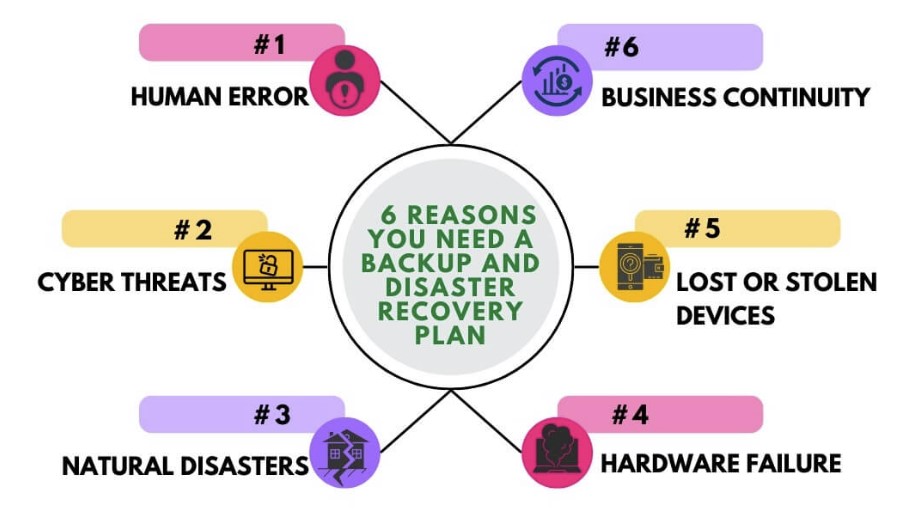Disaster Recovery
Your Emergency Playbook
A Disaster Recovery Plan (DRP) is the manual for your Disaster Recovery. Think of it as a playbook for when things go wrong. A good Disaster Recovery plan (DRP) includes a detailed approach to be followed when an unexpected incident threatens the continuity of your organization's operations. It outlines the responsibilities of each team member in responding correctly and adequately to a disaster. In short, it helps your organization ensure business continuity in the event of an incident.
Benefits of Disaster Recovery Plans
Disaster recovery and business continuity plans make a business more secure and adaptable. Having a plan reduces the need for on-the-spot improvisation and puts less pressure on employees and individuals to make decisions in the face of adversity. Additional benefits of this documentation include:
Improves confidence in customers, employees, and shareholders
Ensures compliance with industry standards
Preserves brand value and reputation
Helps mitigate financial risk
Minimizes damage from changes in supply chains
Preserves and restores any assets that are put at risk by a disaster or disruption
Allows an organization to resume regular operations more quickly


Minimize Downtime, Maximize Security
Did you know that after a cyberattack, the average organization often needs weeks or months to resume normal operations? If a restored backup isn't current, data may be partially or entirely lost, or a hacker might demand thousands of euros in ransom to unlock your data. Such downtime can significantly affect the organization's functionality.
The value of a robust Disaster Recovery plan is clear when your organization suffers a cyberattack. The consequences are extensive, impacting not only the organization, its employees, suppliers, and customers through direct damage but also leading to consequential damages. These may include compliance issues, leaked information, lost orders, reputational harm, liability claims, or customer loss, potentially causing significant escalation.
Ensure Your Business Continuity with Our Disaster Recovery Solutions
Contact ServerDirect to discover how our tailored disaster recovery solutions can safeguard your organization's critical data against any eventuality. Our expertise ensures swift recovery and minimal downtime, enabling your business to maintain operations seamlessly during crises. Let us help you fortify your data resilience and protect your future.

Safeguard Your Business with Dual-Located, Secure Data Backups
Disaster Recovery is crucial for restoring your business-critical systems after a disaster, using well-planned backups to ensure continuity. To protect against disasters, it's recommended to replicate your data at a distant location. This approach shields your backups from local disasters, such as fires or floods, and from cybercriminals and accidental human errors.

Regrettably, the need for such precautions is growing. For example, if a flood destroys your servers, you would lose all data on them. Without externally stored backups, your organization could lose all its data, exacerbating the disaster. Disaster Recovery highlights the necessity of duplicating data in two locations. In the event of a disaster, you can switch to these external servers or move the data back to new servers on your premises, swiftly resuming business operations.
Tailored Recovery Solutions for Every Need
Recovery backup and data recovery play a critical role in ensuring data integrity and availability. Here are some of the key hardware solutions used in the industry:
External Hard Drives: Portable and easy to use, external hard drives are a simple solution for backing up data from computers and servers.
Network Attached Storage (NAS): NAS devices provide centralized data storage over a network, allowing multiple users and devices to access and back up data simultaneously.
Tape Drives and Tape Libraries: Despite being an older technology, tape drives are still used for their cost-effectiveness and reliability for long-term data storage and archiving.
Solid-State Drives (SSDs): Used in both internal and external capacities, SSDs offer fast data transfer rates and reliability for backup and recovery processes.
Storage Area Network (SAN): SANs are high-speed networks of storage devices that can be accessed by multiple servers, offering a scalable and flexible solution for large-scale data storage and backup.
Direct Attached Storage (DAS): DAS refers to storage devices directly connected to a computer or server, providing dedicated storage capacity for backup and recovery.
Cloud Storage Gateways: These appliances serve as a bridge between on-premises data storage and cloud storage, facilitating the backup of data to cloud services for disaster recovery purposes.
USB Flash Drives: For small-scale or individual backup needs, USB flash drives are a convenient and portable option.
Disk Arrays with RAID Configuration: Disk arrays configured with Redundant Array of Independent Disks (RAID) technology provide redundancy, helping to protect data against drive failures.
Disaster Recovery Appliances: Specialized appliances that provide not just data backup but also services like data deduplication, replication, and recovery in a single device.
Each of these hardware solutions offers distinct advantages and can be selected based on the specific backup and recovery needs of an organization, including the amount of data, the required speed of recovery, and budget considerations.




Schrijf in voor onze Nieuwsbrief
Hebt u vragen of hulp nodig? Wij helpen u graag.
